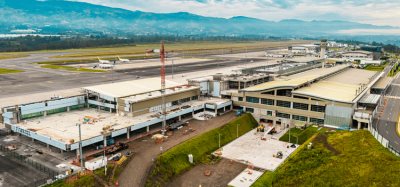ACI finds passenger traffic growth slows but freight market regains strength
- Like
- Digg
- Del
- Tumblr
- VKontakte
- Buffer
- Love This
- Odnoklassniki
- Meneame
- Blogger
- Amazon
- Yahoo Mail
- Gmail
- AOL
- Newsvine
- HackerNews
- Evernote
- MySpace
- Mail.ru
- Viadeo
- Line
- Comments
- Yummly
- SMS
- Viber
- Telegram
- Subscribe
- Skype
- Facebook Messenger
- Kakao
- LiveJournal
- Yammer
- Edgar
- Fintel
- Mix
- Instapaper
- Copy Link
Posted: 22 November 2018 | International Airport Review | No comments yet
ACI World has found a 5.4 per cent increase in global passenger traffic on a year-on-year basis in July as freight traffic regains steady increase.


ACI collects and analyses data from a significant sample of airports that provide regular reports on month-by-month passenger and freight statistics; this forms part of the world’s most comprehensive source for airport data.
Year-to-date growth for the industry’s passenger market reached 6.4 per cent during the period, down from 6.6 per cent in June, following a slight moderation trend which started at the end of the first quarter of the year. Freight volumes benefited from a small uptrend in July, growing by 3.2 per cent compared to June’s 2.3 per cent. Year-to-date figure growth for the global industry reached 4.5 per cent during the period, from 4.8 per cent at the end of the second quarter of this year.
Angela Gittens, Director General, ACI World said: “The global aviation industry achieved particularly strong results in 2017. Although 2018 figures up to July remain robust, achieving similar results may prove difficult this year. Furthermore, it is clear that trade tensions around the world are starting to take their toll on global exports. International passenger traffic, which had been benefiting from a significant upsurge since the start of the year, slowed down in July. This brought the segment’s growth rate closer to the results posted by the domestic market.”
Passenger traffic
Passenger traffic grew at a robust rate, with the international market reaching 5.8 per cent and its domestic counterpart reaching 5.1 per cent. Year-to-date figures stood at 7 per cent and 5.8 per cent respectively by July’s end.
The major markets of Asia-Pacific, Europe and North America all posted comparable figures for total passenger traffic during the period, increasing by 5.9 per cent, 5.1 per cent and 5 per cent respectively. Despite the close results for July, Asia-Pacific maintained its lead against the two other regions on a year-to-date basis, reaching 8.2 per cent, against 6.4 per cent for Europe and 5.2 per cent for North America.
North America’s performance remained robust given its mature market status. The region’s slight slow-down was driven almost entirely by its international passenger market, which dropped from a 7.3 per cent growth figure in June to 4 per cent in July.
The Middle East’s passenger market, seemingly heading for an annual decline up to June, has been picking up speed since then. The region posted a 6.9 per cent increase in July, after a surprisingly high 8.5 per cent one month prior. The two strong months boosted its year-to-date growth to 1.7 per cent by the end of the month, from -0.8 per cent in May.
Finally, Latin America’s momentum recovered in July with growth of 4.8 per cent on a year-over-year basis, after posting a fairly slow month of June (having posted 2.7 per cent). Faced with a cycle of macroeconomic shocks in large economies such as Brazil and Argentina, the region has been growing at a particularly middling rate in the last two years.
Freight volumes
Global air freight trends seemed to be tracking the evolving trade context around the United States in July, with international freight continuing its slow-down to 3.9 per cent growth on a year-to-date basis, from 4.4 per cent in June. At the same time, domestic freight performed relatively well during the period, gaining 7 per cent on a year-over-year basis and boosting its year-to-date figure to 5.8 per cent. This partially balanced the slow-down in international trade, but in the long-run could not fully offset the economic impacts of a declining international freight market, which represents roughly twice the size of the domestic segment.
Of the three major regional markets, North America’s total freight volumes fared the best in July (4.1 per cent), followed by Europe (2.9 per cent) and Asia-Pacific (2.5 per cent). Year-to-date figures for all three markets have been slowly but steadily decreasing since Q1. North America stood at 5.4 per cent at the end of the period, with Asia-Pacific reaching 4.1 per cent and Europe 3.5 per cent.
After a sharp drop to 1.7 per cent growth in June, North America posted a 4.1 per cent increase in July. As could be expected given the current state of international trade relations, the entire upswing was driven by growth in domestic freight, which increased by 7.7 per cent during the month on a year-over-year basis. International freight, on the other hand, declined by 1 per cent.
Turkey’s recovering market (+12.9 per cent) and Belgium’s burgeoning cargo industry (+14.6 per cent) remained the main drivers of Europe’s growth in July, while other major markets sustained subdued or even negative growth on a year-to-date basis.
Asia-Pacific remained negatively affected by the global trade context, with a number of major markets posting figures approaching zero percent growth in July on a year-over-year basis.
Latin America performed relatively well in July, increasing 4.6 per cent on a year-over-year basis, only behind Africa for the period. As with the latter, the air freight market seems on track to post substantial gains in 2018, with year-to-date reaching 9.7 per cent.
Africa’s freight figures slowed down in July, after benefiting from a surge of close to 18 per cent in June. The region posted 6.2 per cent growth during the period, with year-to-date figures remaining above double-digits at 11.6 per cent.
In line with its passenger traffic, the Middle East’s freight market rebounded in July, after posting a decline of 1.2 per cent in June. Year-over-year growth reached 3.2 per cent, keeping the region’s year-to-date figure above the zero percent mark, at 0.7 per cent. It had reached 0.2 per cent in June. As has been the case since the start of the year, the region’s outlook remained uncertain by the end of July.
Related topics
Aeronautical revenue, Air freight and cargo, Airside operations, Capacity, Economy, Passenger volumes


















